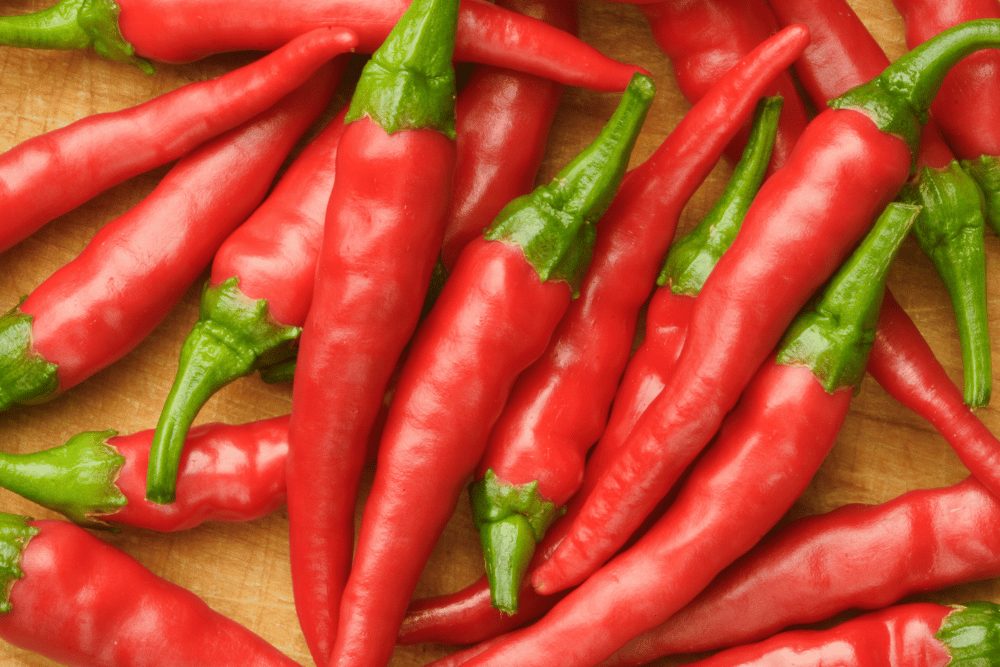Native to French Guiana in South America, Cayenne peppers are medium-hot peppers grown globally for their heat and neutral peppery flavor. They are available in many varieties, with red ones being the most common. Cayenne peppers are generically associated with red pepper flakes and powder.
What Is Cayenne Pepper?
Cayenne pepper is a long, slender Capsicum annuum cultivar native to Cayenne in French Guiana, South America. The pepper belongs to the same species as jalapenos, New Mexico chili peppers, and bell peppers.
Origins
Peppers in the Capsicum annuum species are endemic to South and Central America. Spanish explorers discovered them in the 15th century during the Columbian exchange and introduced them to Europe, and they spread to other parts of the world.
There are different accounts for the naming of Cayenne peppers. Some say the peppers are named for the Cayenne River. Others say they were used for a long time in French Guiana, and the City of Cayenne was named after the peppers.
Despite the disputed origins of the peppers, one thing is for sure: they ultimately traveled farther afield and are now globally popular. They are famously cultivated in the US, India, Mexico, and East Africa.
Color
Cayenne peppers ripen from green to vibrant red at full maturity. It takes 2-4 weeks after reaching mature size for the peppers to ripen to red. Some Cayenne varieties ripen to purple, orange, or yellow.
Varieties
There are many Cayenne cultivars and cayenne-type peppers grown today. These are differentiated by attributes like color and the names they get in the regions where they are cultivated. Some are Cayenne pepper hybrids.
You are likely to come across various types of Cayenne peppers, such as:
- Red ember (A hybrid and 2018 AAS winner)
- Buena mulata
- Ring of Fire Cayenne
- Cayenne Sweet
- Golden Cayenne
- Cayenne Purple/Purple Cayenne (Matures to purple)
- Red Flame (A hybrid bred by Janika Eckert)
- Pepper Cayennetta/Cayennetta Pepper (A hybrid and AAS winner)
- Carolina Cayenne/Cayenne Carolina
- Cayenne Long hot thin
- Dagger Pod pepper (A cayenne-type pepper)
- Cayenne Sweet/Sweet Cayenne (zero-heat peppers)
- Cayenne Buist’s Yellow Pepper
Size And Shape
Cayenne chili peppers are long, slender, curved, and tapering to a point. Some may be curly or have a curved tip. The peppers are about 3-6 inches long and 0.5 inches wide at full maturity.
Texture
The thin skin of Cayenne hot peppers is waxy, slightly wrinkled, glossy, firm, and somewhat rippled.
Flavor
Unlike most other peppers, Cayenne peppers aren’t known for their richness of flavor. Green Cayenne peppers have a slightly bitter, vegetative, or grassy taste reminiscent of immature green bell peppers or filius blue pepper.
When ripe, Cayenne peppers have a neutral peppery flavor, much like ornamental peppers such as black cobra, aurora, and black pearl peppers.
The lack of specialty in flavor is a good thing. The neutral peppery flavor means they do well in various dishes and red pepper products where heat is needed without altering the taste.

How Spicy Is Cayenne Pepper?
Cayenne peppers are medium-heat peppers with a Scoville Scale heat range of 30,000-50,000 Scoville Heat Units. Some varieties, such as Sweet Cayenne, may be milder at as low as 5,000 SHUs or have zero heat.
Other hot peppers with the same heat range of 30,000-50,000 SHUs include rooster spur peppers, filius blue peppers, NuMex twilight, tabasco, isot peppers, and aji charapita.
Culinary Uses For Cayenne Pepper
Cayenne peppers are as versatile as they are popular. You can use them in cooking in the following ways:
- As ground Cayenne powder (This is often generically called red pepper. It’s made from dried and ground Cayenne peppers.)
- Making homemade hot sauce.
- Making tabasco sauce and other hot sauces, especially those containing vinegar.
- Chop into spicy salsa.
- Steep dry Cayenne hot chili peppers in hot water and use the steeping water to flavor soups and stews.
- Dry and grind red Cayenne peppers into a dry rub for poultry and meats. (Cayenne is often paired with lime or lemon juice in this way.)
- Mix into hummus.
- Making homemade candy. Melt chocolate and flavor it with cayenne pepper powder, then dip strawberries in the mixture to make a sweet and spicy dessert.
- When ground, as a garnish for eggs, pizza, sandwiches, and popcorn.
- As a spicy marinade with Cayenne peppers, garlic, vinegar, and olive oil.
Health Benefits Of Cayenne Pepper
Did you know that Cayenne peppers are used in skin creams and health supplements? The capsaicin, nutrients, and antioxidants deliver health benefits. Hot peppers can also help the body fight germs by enhancing the immune system.
Capsaicin, the pepper compound that causes the burning sensation, acts as a pain relief agent by reducing the amount of Substance P, a neuropeptide associated with pain signals. Substance P also helps lower cholesterol and increase body cells.
When used as a skin cream, topical capsaicin helps treat psoriasis, a no-cure autoimmune condition that causes skin itching, scaliness, and red-patching. Topical capsaicin creams also help reduce pain and inflammation from arthritis.
Cayenne peppers also have antioxidants like Vitamin A, beta carotene, choline, Vitamin C, lutein, and Vitamin E. They have nutrients like folate, potassium, Vitamin B1, manganese, magnesium, iron, Vitamin B2, zinc, and Vitamin B6.
Studies indicate that capsaicin can help reduce high blood pressure and the risk of heart disease. It enables the body to release vasodilators like nitric oxide, which cause blood vessels to expand to enhance blood flow.
Hot peppers and spicy food also boost metabolism, making the body burn more calories. Eating the peppers also helps with weight loss since they reduce hunger pangs, making you eat less.
Where To Buy Cayenne Peppers
Fresh Cayenne peppers are rare. Supermarkets usually carry ground Cayenne powder or Cayenne pepper flakes. These products, and others like hot sauces, are also available from online sources like Amazon.
Can You Grow Cayenne Peppers?
You can grow your Cayenne peppers if you have a green thumb. The peppers are moderately hard to grow because they are prone to either overly cold or hot weather.

You can grow the peppers from Cayenne pepper seeds available on Amazon and online seed catalogs. It’s also possible to grow them from stem cuttings.
Once you obtain the seeds, pre-culture them indoors 8-10 weeks before the last spring frost date to germinate in 7-21 days. Transplant the pepper plants when they develop six true leaves.
Cayenne peppers thrive in moist, well-drained soil and full sun with an exposure time of at least six hours daily when it’s sunny. The garden spacing should be 18-24 inches between the plants in a row.
Each open-pollinated Cayenne pepper plant will prolifically produce 30-80 peppers per season, depending on the variety. It takes 70-100 days for the peppers to reach their mature harvesting stage.
Substitutes For Cayenne Peppers
Because of the neutral flavor of Cayenne peppers, you can replace them with many other red peppers and hot pepper products in cooking. You can use the following alternatives:
- Tabasco sauce
- Hot paprika
- Crushed red pepper flakes or red chili flakes
- Gochugaru pepper
- Red serrano peppers
- Jalapeno pepper powder
- Chili powder

